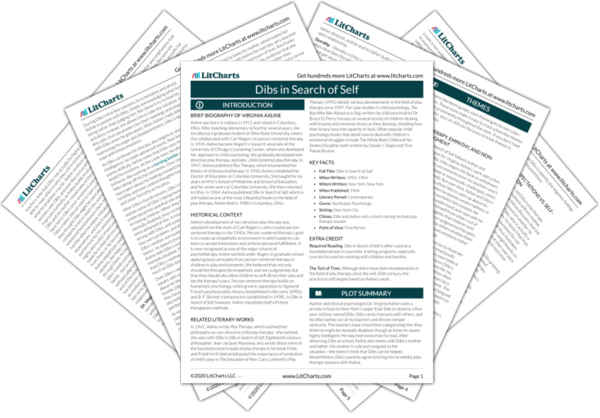Summary
Analysis
Axline arranges to meet with Dibs’s mother at their family’s home: a brownstone on the Upper East Side. When Axline arrives, she notes that the house is very beautifully furnished and well-kept; there are several staff members. As she’s led to the drawing room, she hears the muffled sound of Dibs screaming, “No lock door!”
Dibs’s screams make clear in part where some of his emotional distress comes from. He is often punished for not fully adhering to his parents’ expectations, and the locked doors again symbolize the fact that he is often shut out of his parents’ lives and he lacks their emotional support.
Themes
In the drawing room, Dibs’s mother greets Axline and tells her that she and Dibs’s father have resigned themselves to Dibs’s situation: they doubt that he can get better. However, she hopes that Axline’s study can help other children or further her understanding of human behavior. Axline is astonished to hear Dibs’s mother describe him so scientifically and unemotionally.
Here Axline foreshadows her belief that much of Dibs’s emotional deprivation stems from his mother’s inability to fully express her own emotions or relate to Dibs. She also uses her intelligence as a shield to avoid her emotions, showing that intelligence and emotion are often in conflict with one another.
Themes
Dibs’s mother asks if Axline can study Dibs in his playroom at home, but Axline says that it would be better to see Dibs in the Child Guidance Center, once a week for an hour. Dibs’s mother tries to offer a higher fee, but Axline refuses a fee entirely. Instead, Axline asks for Dibs’s parents’ written permission to record all of her interviews of the family. She says that all of their identifying information will be disguised.
Dibs’s mother’s desire for Axline to see Dibs in their playroom foreshadows her shame over her son and the fact that she doesn’t want to be judged for what she views as a failure in her family. She would rather keep him—and herself—isolated in order to avoid judgment.
Themes
Axline hands Dibs’s mother a written statement of this agreement, and Dibs’s mother says that she’ll look it over with Dibs’s father. Axline notes that Dibs’s mother is very sad and remote. She also seems terrified; she tells Axline that she won’t be able to come in for interviews herself, and nor will her husband. Axline says that she understands, but she adds that if Dibs’s mother ever does want to talk to her, she should feel free to get in touch. The two women then make further small talk about Dibs’s sister Dorothy, whom Dibs’s mother refers to as a “perfect child.” Axline notes that Dibs’s mother seems more anxious in this interview than Dibs was in his first session. Dibs’s mother says that she’ll let Axline know as soon as they decide whether to allow Axline to hold play therapy sessions with Dibs.
Dibs’s mother’s terror at the thought of being interviewed hints at what she will later reveal about a previous experience that she had with psychiatrists. She doesn’t want to be judged or evaluated for her parenting as she was in that instance. Axline connects Dibs’s mother to Dibs, demonstrating how Dibs’s mother is similarly anxious about being judged. Ironically, Dibs’s mother then demonstrates how she constantly judges Dibs by comparing him to his “perfect” sister.
Themes
Get the entire Dibs in Search of Self LitChart as a printable PDF.

After the interview, as Axline leaves, she thinks that Dibs’s bedroom very likely has every toy money can buy—but it also has a door and a secure lock. She wonders why Dibs’s mother is so terrified about the prospect of being interviewed. Axline hopes that she handled the interview in the right way and that Dibs’s parents will agree to let her see Dibs.
Axline again highlights the tension between Dibs’s intelligence and his emotional capabilities. It doesn’t matter that he has toys and books that can help him develop intelligence: the locked doors in his life prevent him from forging emotional connections with other people and allowing that intelligence to flourish.
Themes












